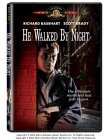
| Cast: | Richard Basehart, Scott Brady, Roy Roberts, Whit Bissell, Jack Webb |
| Genre: | Crime/Film-Noir/Drama |
| Director: | Anthony Mann & Alfred L. Werker |
| Screenplay: | John C. Higgins & Crane Wilber from Wilbur's story |
| Cinematography: | John Alton |
| Composer: | Leonid Raab |
| Runtime: | 79 minutes |
Certain filmmaker’s styles seem to only work if strictly adhered to. Robert Bresson was in his infancy in 1948 having made Les Dames du Bois de Boulogne; full refinery of his style wouldn’t come until 1956’s A Man Escaped. This tight little Poverty Row film actually contains many characteristics that would become associated with the work of Bresson (and Jean-Pierre Melville), even though they are largely used for different ends.
|
Despite all these Bressonian elements, the film is largely done in an expressionist style that regularly evokes Fritz Lang. John Alton’s brilliant geometric cinematography uses square and rectangle sets, but turns them diagonal through his angular camera placement. Alton uses deep focus photography, but our attention is somewhat directed because circular objects offset the square architecture. Continuing his experiments with high contrast black and white, floods of light are often all that illuminates the extremely dark screen. In most cases, the foreground is dark with the light residing in the outer edges of the frame to create an effect that’s arguably as close as a two dimensional film can come to looking three dimensional.
I wouldn’t think the combination of Bresson & Lang could possibly work, but Bresson takes care of the meticulous everyday scenes of the individuals while Lang makes the cat and mouse game exciting. The problem with procedural films is they tend to be rather dull and propagandistic. Good and bad are clearly defined and the outcome is a given since so much time is devoted to agency aggrandizement. There is no deeper message than crime doesn’t pay as long as the force has a few good men and the citizens support their local sheriff! Instead of only following the good guys, He Walked splits the time between cop and robber, allowing the audience to be impassive observers of the facts.
The main problem with Walked is the characters are paper-thin. Though he has no redeeming personal qualities we can’t help but respect the bad guy’s skills and smarts. After all, he stays one or two steps ahead of the entire police force without anyone’s help. The cop killer Roy Martin (Richard Basehart) is based on Erwin “Machine Gun” Walker, but essentially all we learn about him is he’s a detached, paranoid, alienated, disenchanted WWII veteran whose only relationship is with a dog. He’s an electronics wizard and someone that certainly doesn’t have to rob and kill, but like the cops all we see him doing is his job.
Alfred L. Werker was replaced a few weeks into production. Though he still receives directorial credit, it’s clear from watching Railroaded!, T-Men and Raw Deal that the film belongs to Mann’s series of crime noirs. Though John C. Higgins contributed the script to all four, it’s first and foremost the composition and chiaroscuro camerawork of John Alton, who lensed the final three, that indicate Mann’s direction.
|
The final scene where Roy tries once again to utilize the miles of storm drain tunnels under Los Angeles to escape the police is one of the all time greats. The fact that it’s not only superior to the tunnel chase in The Third Man, but filmed a year prior to Carol Reed’s masterpiece should tell you something about the visuals the Mann and Alton combo deliver. The scene emphasizes the many fine qualities of Mann’s crime noirs, it’s tense, suspenseful, claustrophobic, mazelike, and brilliantly lit (largely by the flashlights the cops are carrying). He Walked by Night isn’t Mann’s deepest film, that would be The Naked Spur. You could easily argue that T-Men or Raw Deal were visually better; I think the composition is more carefully constructed in Walked but there aren’t as many scenes that lend themselves to flashiness. Perhaps the film looks better when compared to everything else rather than Mann’s own work, as I’d gladly stack this up against any police procedural America ever produced.
    |

|
|

|
|
|
|
|
|
|
|
|
|
|
|
|
|
|
|
|